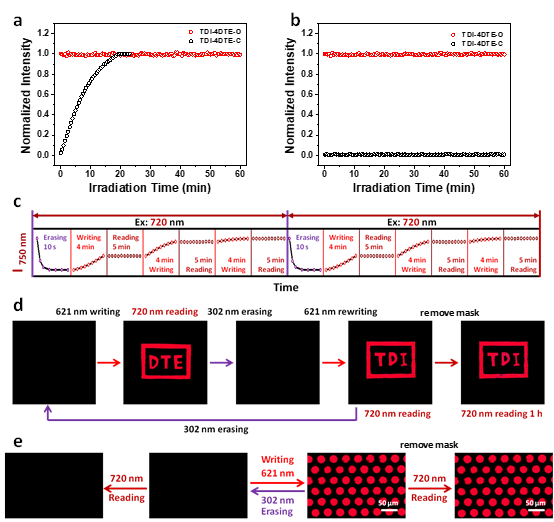Nondestructive readout is indispensable for optical memories. The fluorescence of photoswitchable fluorescent dithienylethene (DTE) could be reversibly switched ON and OFF upon alternating UV and visible light irradiations. That is a digital switch in single molecular scale. Due to their excellent fatigue resistance and unique thermal bistability, DTE based fluorescent molecular switches stand out form a series of fluorescence molecular switches and show great potential for applications in high density optical imaging. However, for the conventional visible light emissive DTEs, the readout of fluorescence from DTE will cause the break of signal. The fluorescence quenching mechanism of closed form DTEs is commonly energy transfer (ET) which will be able to cause the photocycloreversion reaction. In addition, the direct absorption of fluorescence excitation light will also induce the photoisomerization reactions. Thus, the crosstalk between reading and writing/erasing wavelengths leads to destructive fluorescence readout. To address this problem, the quenching mechanism of photoinduced electron transfer (PET) for closed form DTE has been proposed. This strategy requires the excitation wavelength are longer than the photochromism responsive wavelengths of DTEs and the match of redox properties of the photochromic DTE isomers and fluorephore to make sure high efficient electron transfer is thermodynamically favourable only to one of the two isomers. Although nondestructive readout has been achieved by taking above strategy, their practical application ability in optical memory are poor due to the low fluorescence switch ratio (usually less than 10 : 1) and strong dependence on polar solvent.

Figure 1 The schematic of fluorescence photoswitching process of near infraredfluorescence molecular switch TDI-4DTE
In view of this, Professor Zhu and Li's group at Wuhan National Laboratory for Optoelectronics, Huazhong University of Science and Technology, have coupled four photochromic DTEs to the bay positions of a photostable and bright near-infrared fluorophore terrylenediimide (TDI) through oxygen bridges to get a symmetric tetra-armed dithienylethene-terrylenediimide near infrared fluorescence molecular switch, named TDI-4DTE. The near-infrared absorption and emission of TDI are both longer than the absorption of closed-form DTE and the match of redox potentials between TDI and DTE can achieve efficient PET process for the fluorescence quenching of only closed form DTE. Therefore, we can choose a specific long wavelength as the fluorescence readout light to excite the TDI core without causing any photoisomerization reactions of DTE, so as to realize the nondestructive fluorescence readout. In addition, each DTE unit in TDI-4DTE can be switched effectively and independently. The maximum conversion yield from open form DTE to closed form one is about 94.3%. If only one DTE unit in a TDI-4DTE molecule is closed, it fluorescence is completely quenched. Thus the proportion of TDI-4DTE with all DTE units in open form is extremely small upon UV irradiation and that enables an enormous fluorescence on/off ratio of > 3000 : 1.

Figure 2 The demonstration of nonvolatile erasable nondestructive readout optical memory using the polymer film doped by TDI-4DTE. The trace of fluorescent intensity at 750 nm of TDI-4DTE in PMA film upon continuing excitation with monochromatic light at (a) 621 nm (destructive readout) and (b) 720 nm (non-destructive readout). (c) the change of fluorescence intensity at 750 nm, (d) fluorescence photographs and (e) fluorescence microscopic images upon 302 nm (erasing), 621 nm (writing) and 720 nm (reading) light irradiation, showing the erasable optical memory behavior and non-destructive fluorescence readout capability
TDI-4DTE exhibits a high fluorescence on/off ratio, excellent reversibility and great fatigue resistancein different media (organic solvent, polymer film, pure solid film). As an information storage material, the fluorescence of TDI-4DTE molecules in the polymer film can be written by red light (621 nm), erased by UV light (305 nm), and read out (750 nm) in a nondestructive manner. The functions of above three wavelengths are deciphered and independent to achieve nondestructive readout of fluorescence signal. As shown in Figure 2, the change of fluorescence intensity at 750 nm andfluorescence microscopic images upon three-color light irradiations of TDI-4DTE doped PMA films demonstrate the erasable optical memory behavior and the nondestructive fluorescence readout capability. The fluorescence intensity of TDI-4DTE at 750 nm decreases rapidly upon several seconds of 302 nm irradiation and finally reaches the nonfluorescence dark state. It will gradually recover followed by the writing process of 621 nm light irradiation. The emission intensities at any states of TDI-EDTE keeps constant under continuous 720 nm illumination, which confirms the nondestructive readout character of TDI-4DTE. The two isomers of TDI-4DTE are both thermally bistable and their ON/OFF fluorescence states correspond to the digital codes of 1 and 0. Therefore, the fluorescence signal will not loss after removing of light irradiations and standing for a long time in dark. The recording of optical information is nonvolatile using TDI-4DTE and exhibits excellent fatigue resistance. TDI-4DTE with unique and prominent optical properties is promising for application in high-density erasable nonvolatile molecular optical memory. .
This work is published online inACS Applied Materials & Interfaces.Prof. Ming-Qiang Zhu and Dr. Chong Li are the corresponding authors. Dr. Nuo-Hua Xie is the first author. This work was supported by the National Basic Research Program (973) of China, the National Natural Science Foundation of China, the Fundamental Research Funds for the Central Universities, and the Nature Science Foundation of Hubei Province.
Full text is available athttps://pubs.acs.org/doi/abs/10.1021/acsami.9b05417.
Title:Deciphering Erasing/Writing/Reading of Near-Infrared Fluorophore for Nonvolatile Optical Memory.